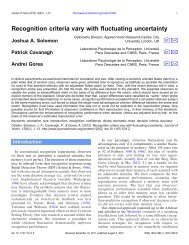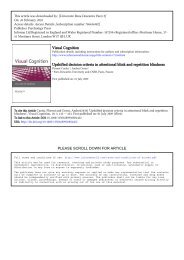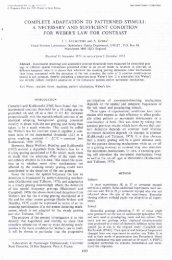Signal Detection Theory and Psychophysics - Andrei Gorea
Signal Detection Theory and Psychophysics - Andrei Gorea
Signal Detection Theory and Psychophysics - Andrei Gorea
You also want an ePaper? Increase the reach of your titles
YUMPU automatically turns print PDFs into web optimized ePapers that Google loves.
d’ with unequal varianceszH210-1-2d’ a'd 1in s N units'd Y / Nd-2 -1 0 1 2zFA''a 2dY / N R/d’ a'd2in s S unitss21 sThe index d a has the properties we want.221. It is intermediate in size between d 1 <strong>and</strong> d‘ 2 .2. It is equivalent to d' when the ROC slope is 1,for then the perpendicular line of length D Y/Ncoincides with the minor diagonal, <strong>and</strong> the twolines of length d a coincide with the d' 1 , <strong>and</strong> d' 2segments.3. It turns out to be equivalent to the differencebetween the means in units of the root-meansquare(rms) st<strong>and</strong>ard deviation, a kind ofaverage equal to the square root of the mean ofthe squares of the st<strong>and</strong>ard deviations of S1<strong>and</strong> S2.To find d a from an ROC that is linear in z coordinates, it iseasiest to first estimate d’ 1 , d’ 2 <strong>and</strong> the slope s = d’ 1 /d’ 2 .Because the st<strong>and</strong>ard deviation of the S1 distribution is stimes as large as that of S2, we can set the st<strong>and</strong>arddeviation of S1 to s <strong>and</strong> that of S2 to 1.To find d a directly from one point on the ROC once s is known:dd'a'ad'2.5 1s²zH sz.5F d'2 2 1s² 2 1s² .5.5








